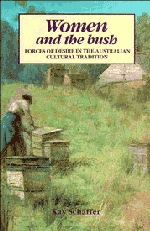Book contents
- Frontmatter
- Contents
- ACKNOWLEDGEMENTS
- INTRODUCTION
- Dedication
- CHAPTER 1 CULTURE, LANGUAGE AND THE SELF
- CHAPTER 2 IN SEARCH OF A NATIONAL IDENTITY
- CHAPTER 3 THE BUSH AND WOMEN
- CHAPTER 4 LANDSCAPE REPRESENTATION AND NATIONAL IDENTITY
- CHAPTER 5 HENRY LAWSON: THE PEOPLE'S POET
- CHAPTER 6 BARBARA BAYNTON: A DISSIDENT VOICE FROM THE BUSH
- CHAPTER 7 CONCLUSION
- NOTES
- BIBLIOGRAPHY
- INDEX
CHAPTER 1 - CULTURE, LANGUAGE AND THE SELF
Published online by Cambridge University Press: 10 January 2011
- Frontmatter
- Contents
- ACKNOWLEDGEMENTS
- INTRODUCTION
- Dedication
- CHAPTER 1 CULTURE, LANGUAGE AND THE SELF
- CHAPTER 2 IN SEARCH OF A NATIONAL IDENTITY
- CHAPTER 3 THE BUSH AND WOMEN
- CHAPTER 4 LANDSCAPE REPRESENTATION AND NATIONAL IDENTITY
- CHAPTER 5 HENRY LAWSON: THE PEOPLE'S POET
- CHAPTER 6 BARBARA BAYNTON: A DISSIDENT VOICE FROM THE BUSH
- CHAPTER 7 CONCLUSION
- NOTES
- BIBLIOGRAPHY
- INDEX
Summary
Australia is a country of contradictions. The earliest historical records attest that this has been so since the first narratives of exploration reached the eyes and ears of an eager European audience. At least two opposing views prevailed. One held that this phantom continent, known only as Terra Australis Incognita, was a land of teeming richness abounding with ‘Gold, Silver, Pearls, Nutmegs, Mace, Ginger, and Sugar-canes of an extraordinary Size’. Another described the place as an arid, fly-blown, barren land, unlikely to sustain or nourish human habitation. The first view, reported by de Quiros for the Spanish early in the sixteenth century, referred in fact to an island in the New Hebrides, mistakenly thought to be the southern continent which he called Austrialia del Espiritu Santo. The second and more familiar description was penned by Dampier for the Dutch in his report of his 1688 explorations, New Voyage around the World, which described the north-west coast of the continent in depressingly flat tones. The early writings and the varied experiences of European explorers and settlers in the antipodes gave rise to a Western European conception (which survives today) of Australia as a land of fantastic hopes and harsh realities; a land of ancient secrets and modern discoveries; a land of crude, closed settlements and complex, expanding freedoms. But more than this, the idea of Australia has a long history as a land of desire, traversed in the imaginations of explorers, settlers and visitors alike.
- Type
- Chapter
- Information
- Women and the BushForces of Desire in the Australian Cultural Tradition, pp. 1 - 27Publisher: Cambridge University PressPrint publication year: 1989



